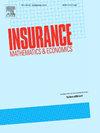Axiomatic risk sharing and capital allocation
IF 2.2
2区 经济学
Q2 ECONOMICS
引用次数: 0
Abstract
We aim to share risky endowments among finitely many agents, subject to liquidity constraints. We axiomatically characterize baseline solutions, which use a baseline vector of fixed contributions and a rationing method. We propose a general fairness condition, that uniquely determines these fixed contributions. The fairness condition is flexible enough to allow for the use of any capital allocation rule. One rule stands out as a K-fair solution: the one implied by the constrained egalitarian rationing rule. It is the unique rule satisfying a lower bound on taking part of the risk, a composition property, and null consistency. Furthermore, we provide two more characterizations of this rule; one based on local symmetry and one based on minimax expected contributions under truncation.
公理化的风险分担和资本配置
我们的目标是在受流动性限制的情况下,将风险禀赋分配给有限多的代理人。我们公理化地描述基线解决方案,它使用固定贡献的基线向量和配给方法。我们提出了一个一般的公平条件,它唯一地决定了这些固定贡献。公平条件足够灵活,允许使用任何资本分配规则。有一条规则作为k公平的解决方案脱颖而出:这条规则隐含在约束平等主义的配给规则中。它是满足承担部分风险的下界、复合性质和零一致性的唯一规则。此外,我们还提供了该规则的两个特征;一个基于局部对称,另一个基于截断下的极小极大期望贡献。
本文章由计算机程序翻译,如有差异,请以英文原文为准。
求助全文
约1分钟内获得全文
求助全文
来源期刊

Insurance Mathematics & Economics
管理科学-数学跨学科应用
CiteScore
3.40
自引率
15.80%
发文量
90
审稿时长
17.3 weeks
期刊介绍:
Insurance: Mathematics and Economics publishes leading research spanning all fields of actuarial science research. It appears six times per year and is the largest journal in actuarial science research around the world.
Insurance: Mathematics and Economics is an international academic journal that aims to strengthen the communication between individuals and groups who develop and apply research results in actuarial science. The journal feels a particular obligation to facilitate closer cooperation between those who conduct research in insurance mathematics and quantitative insurance economics, and practicing actuaries who are interested in the implementation of the results. To this purpose, Insurance: Mathematics and Economics publishes high-quality articles of broad international interest, concerned with either the theory of insurance mathematics and quantitative insurance economics or the inventive application of it, including empirical or experimental results. Articles that combine several of these aspects are particularly considered.
 求助内容:
求助内容: 应助结果提醒方式:
应助结果提醒方式:


